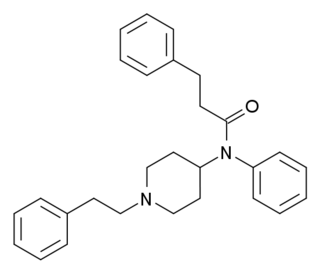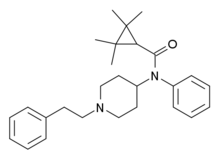
3-Allylfentanyl is an opioid analgesic that is an analogue of fentanyl.

R-30490 is an opioid analgesic related to the highly potent animal tranquilizer carfentanil, and with only slightly lower potency. It was first synthesised by a team of chemists at Janssen Pharmaceutica led by Paul Janssen, who were investigating the structure-activity relationships of the fentanyl family of drugs. R-30490 was found to be the most selective agonist for the μ-opioid receptor out of all the fentanyl analogues tested, but it has never been introduced for medical use in humans, although the closely related drug sufentanil is widely used for analgesia and anesthesia during major surgery.

Furanylfentanyl (Fu-F) is an opioid analgesic that is an analog of fentanyl and has been sold as a designer drug. It has an ED50 value of 0.02 mg/kg in mice. This makes it approximately one fifth as potent as fentanyl.

4-Fluorobutyrylfentanyl (also known as 4-FBF and p-FBF) is an opioid analgesic that is an analog of butyrfentanyl and has been sold online as a designer drug. It is closely related to 4-fluorofentanyl, which has an EC50 value of 4.2 nM for the human μ-opioid receptor.

Acrylfentanyl (also known as acryloylfentanyl or Egyptenyl) is a highly potent opioid analgesic that is an analog of fentanyl and has been sold online as a designer drug. In animal studies the IC50 or half maximal inhibitory concentration for acrylfentanyl to displace naloxone is 1.4 nM, being slightly more potent than fentanyl itself (1.6 nM) as well as having a longer duration of action.

Methoxyacetylfentanyl, commonly known as MAF is an opioid analgesic that is an analog of fentanyl and has been sold online as a designer drug.

Tetrahydrofuranylfentanyl is an opioid analgesic that is an analog of fentanyl and has been sold online as a designer drug, first appearing in Europe in late 2016.

Orthofluorofentanyl is an opioid analgesic that is an analog of fentanyl and has been sold online as a designer drug. While the structural isomer p-fluorofentanyl was one of the first illicit fentanyl analogues identified in 1981, Orthofluorofentanyl did not appear on the illicit market until August 2016.

Cyclopentylfentanyl is an opioid analgesic that is an analog of fentanyl and has been sold online as a designer drug, mainly in Sweden and other Scandinavian countries.

Valerylfentanyl is an opioid analgesic that is an analog of fentanyl and has been sold online as a designer drug. It has been seldom reported on illicit markets and there is little information about it, though it is believed to be less potent than butyrfentanyl but more potent than benzylfentanyl. In one study, it fully substituted for oxycodone and produced antinociception and oxycodone-like discriminative stimulus effects comparable in potency to morphine in mice, but failed to stimulate locomotor activity in mice at doses up to 100 mg/kg.

Isobutyrylfentanyl is an opioid analgesic that is an analog of fentanyl and has been sold online as a designer drug. It is believed to be around the same potency as butyrfentanyl but has been less widely distributed on illicit markets, though it was one of the earliest of the "new wave" of fentanyl derivatives to appear, and was reported in Europe for the first time in December 2012.

4-Chloroisobutyrylfentanyl is an opioid analgesic that is an analog of fentanyl, and has been sold online as a designer drug.

Cyclopropylfentanyl is an opioid analgesic that is an analog of fentanyl and has been sold as a designer drug. Between June and December 2017, a total of 78 cyclopropylfentanyl-related deaths with analytical confirmation in post-mortem samples were reported by various European countries. Another 115 deaths involving cyclopropylfentanyl were reported from the United States in 2017.

Benzoylfentanyl, also known as phenylfentanyl, is an opioid analgesic that is an analog of fentanyl and has been sold as a designer drug. In the United States, benzoylfentanyl was first identified in Drug Enforcement Administration drug seizures in 2018.

Benzodioxolefentanyl is an opioid analgesic that is an analog of fentanyl and has been sold as a designer drug.

3-Phenylpropanoylfentanyl (β'-phenylfentanyl) is an opioid analgesic that is an analog of fentanyl, which was invented in 1981, and has been sold as a designer drug, first identified in March 2017 in Sweden.

4-Methylphenethylacetylfentanyl is an opioid analgesic that is an analog of fentanyl and has been sold as a designer drug.

Isofentanyl (3-methyl-benzylfentanyl) is an opioid analgesic that is an analog of fentanyl first invented in 1973, and which has been sold as a designer drug.

2,2'-Difluorofentanyl is an opioid analgesic that is an analog of fentanyl which has been sold as a designer drug.



















